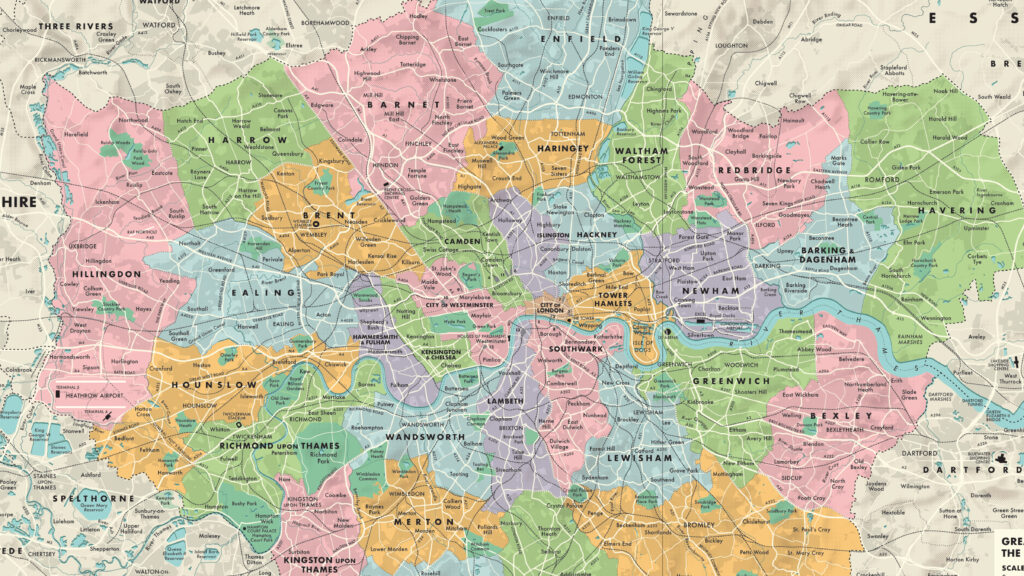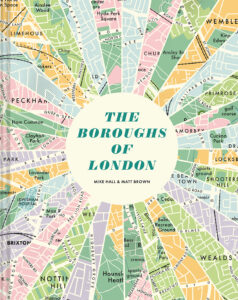A stylish guide to London’s boroughs

Whether you’re a born and bred Londoner, or are simply a fan of the city, peruse the charming and bizarre trivia of some of London’s most well known boroughs in The Boroughs of London. Here’s it’s opening introduction…
by Matt Brown.
Thirty-two. It is the number of pieces on a chessboard; the sum of piano sonatas by Ludwig van Beethoven. It was the final age of Bruce Lee, Alexander the Great, Mama Cass and Keith Moon (the latter two died in the same London bedroom on different dates, incidentally). Adults usually possess 32 teeth. Most importantly for present purposes, 32 is the number of boroughs in Greater London.
Some of the 32 are very famous. Westminster is known the world over thanks to its associations with government and royalty. Greenwich, too, for its connections to time and space. Camden, Hackney and Southwark are on the next tier of recognition; familiar to many if not universal.
And then we have boroughs like Havering and Bromley, whose exact location would stump many Londoners. Hillingdon, too, even though it receives a quarter of a million visitors per day via Heathrow Airport.
London’s 32-borough system has been in place since 1965. It’s had 60 years to bed down. The old ways, however, are tenacious. Many residents of Outer Boroughs such as Waltham Forest, Bromley or Kingston upon Thames still insist they live in Essex, Kent or Surrey. Some people write ‘Middlesex’ in their address, even though the whole county was willed out of existence in 1965. Only about 15 per cent of Londoners are old enough to have witnessed Middlesex as a functioning administration, but it lives on in hearts and minds, especially among cricket fans.
London’s boroughs, then, are slippery beasts. Not everybody understands the borough system, while some wilfully ignore it. Indeed, the whole question of what constitutes London is a difficult one. It has rival answers. Some would contend that an area must possess a London postcode. Others use the M25 orbital motorway as their boundary. Still others would consider anything on the tube map to be within the realms of Cockneydom.
In this book, we take the official view. Greater London comprises the 32 boroughs along with the tiny City of London. No more, no less. If you live within this area, then you pay your council tax to a London borough. You benefit from various services and amenities available only to Londoners. And you have a vote in elections for the Mayor of London and London Assembly. It doesn’t matter if your postcode is HA3 (Harrow) or CR0 (Croydon), you are still part of the Greater London family. You live in a London borough.
What do these boroughs actually do, anyway? All 32 operate in much the same way. The borough looks after most local services, including schools, libraries, planning applications, waste collection and so on. Each is overseen by a borough council, comprising elected officials and sometimes a directly elected borough mayor.
Since 2000, the 32 boroughs have worked alongside a higher tier called the Greater London Authority (GLA). This has responsibility for London-wide services, such as the Metropolitan Police, Transport for London and the London Fire Brigade. The GLA is steered by the Mayor of London and the London Assembly, all of whom are elected by Londoners.
This two-tier system is not quite the whole story. A 33rd local authority can be found within the metropolis. It is not a borough. This is the City of London, or Square Mile to give it the semi-official nickname. This tiny fiefdom has, since time immemorial, looked after itself, largely free of outside administration. The City is the traditional financial centre of London, generating about 2.5 per cent of the UK economy within a space you can walk across in half an hour. It is also the most historic area, with ruins dating back to the Roman occupation almost 2,000 years ago. As we’ll see, it has never quite danced to the same tune as the wider city it helped to create.
This book is a celebration of the 32 boroughs (plus the City) on the occasion of their 60th birthday. We’ll start with a brief introduction outlining how we came to be here; how the haphazard governance of yore slowly coalesced into the present system that, for all its faults, is decidedly more rational and effective than what came before. We then visit every borough in turn. Each is meticulously mapped, and accompanied by our choice of 10 or 12 key locations.
Actually, that last part was the hardest to nail. In a borough like Westminster, say, how do we pick out just a dozen points of interest, when we could field that many from Piccadilly or Whitehall or Strand alone? In truth, we applied no rules. We simply selected a handful of places that offer variety and interest. These are not always the most important or famous locations within a borough. For example, in the Westminster section, we’ve chosen to highlight a water pump in Soho but not the Houses of Parliament. Familiarity breeds indifference. A book full of well-known landmarks would be a chore to read – and to write.
At the same time, we didn’t want to get too obscure, lest this become yet another book of ‘secret hidden gems’. What we alighted upon was something of a balance, mixing locally famous buildings with lesser-known sites. So you’re as likely to find historic boundary markers, gnarled old trees or a clown’s gravestone in these pages as you are to encounter stately homes or small museums. Even so, we can barely scratch the surface of what the 32 boroughs have to offer. You could spend a lifetime exploring these enormous, heterogeneous, richly historic boroughs and still find surprises every day. We hope this book helps you better understand the structure and geography of Greater London. More importantly, we hope it inspires you to explore parts of the capital you might never have considered, and to make your own discoveries.
A note on terminology: throughout this book we’ve referred to important buildings and structures as being ‘listed’. This means the building has special protection from alteration or demolition, conferred by Historic England (formerly English Heritage). Three categories exist: Grade II, Grade II* and Grade I, the last of which is the most significant, indicating a truly exceptional building. Greater London
More about The Boroughs of London:

A stylish collection of beautifully designed maps of each individual London borough, paired with quirky and fascinating facts about what you’ll find there.
Cartographer and illustrator Mike Hall is renowned for his retro-themed print collection of boldly coloured, highly detailed maps of every London borough, inspired by classic 1960s graphic design. Published to coincide with the 60th anniversary of the boroughs’ establishment, The Boroughs of London brings together all of Mike’s London maps in one elegant volume to pore over.
Order your copy here.
Illustrations by Mike Hall.

